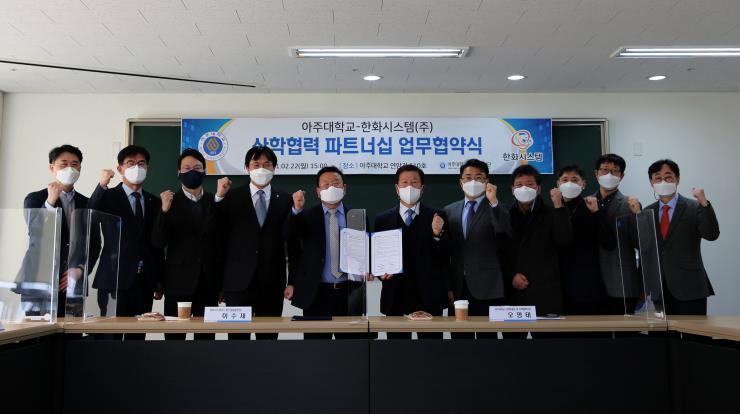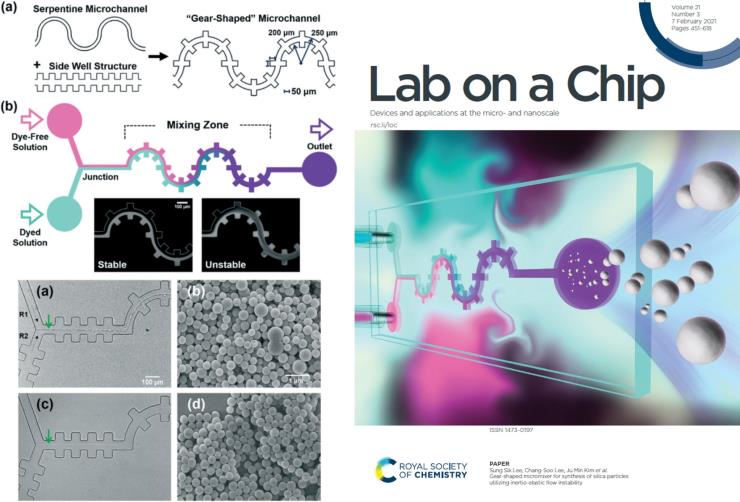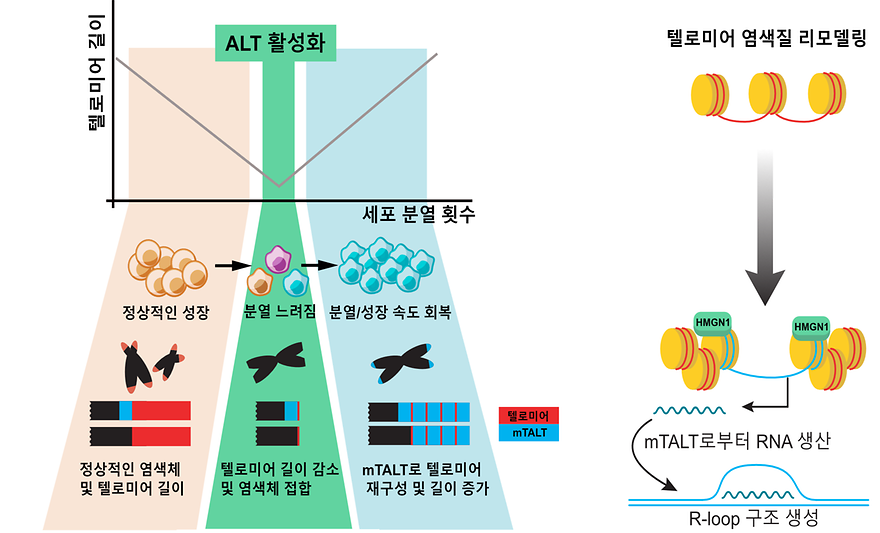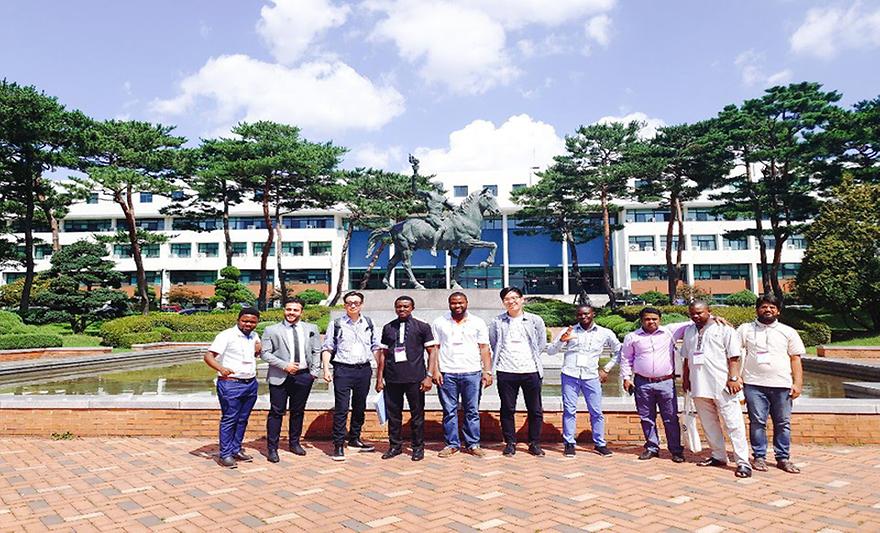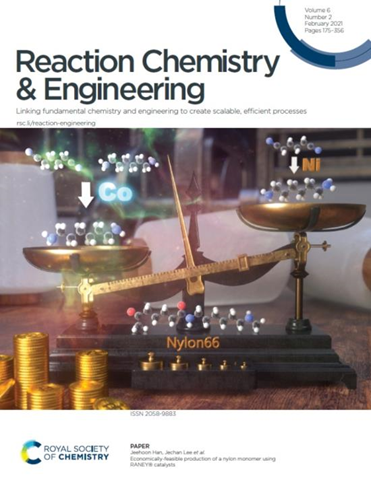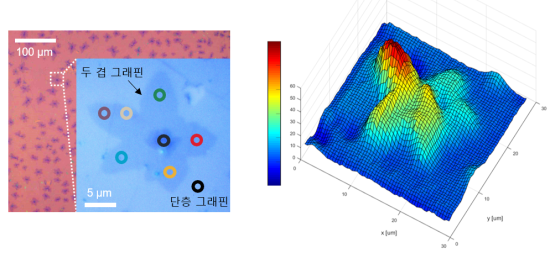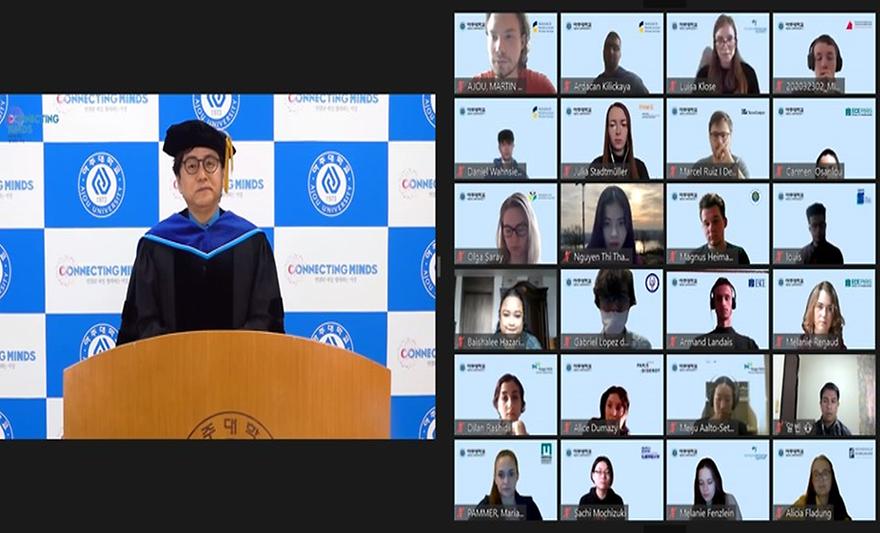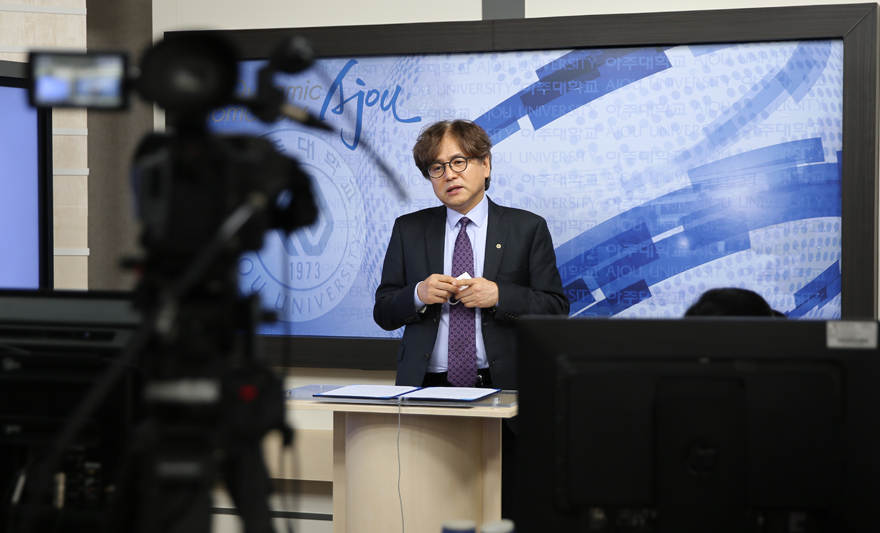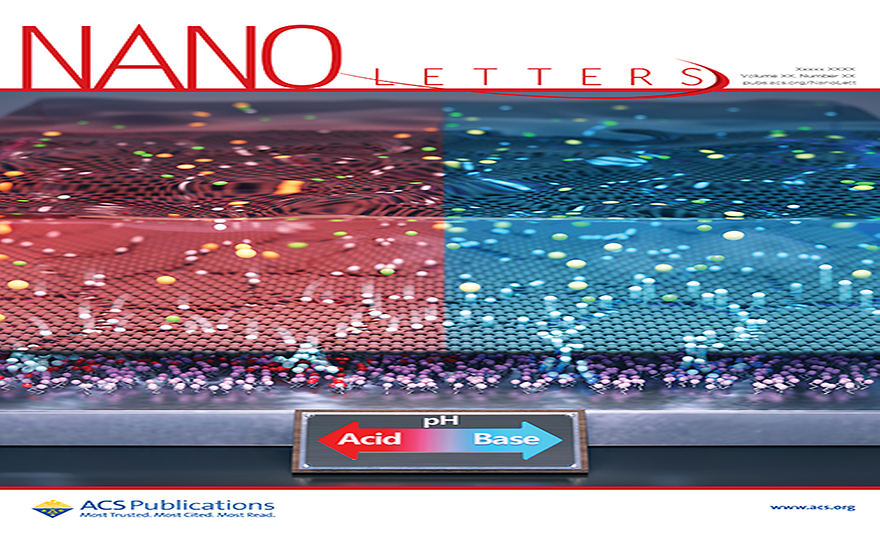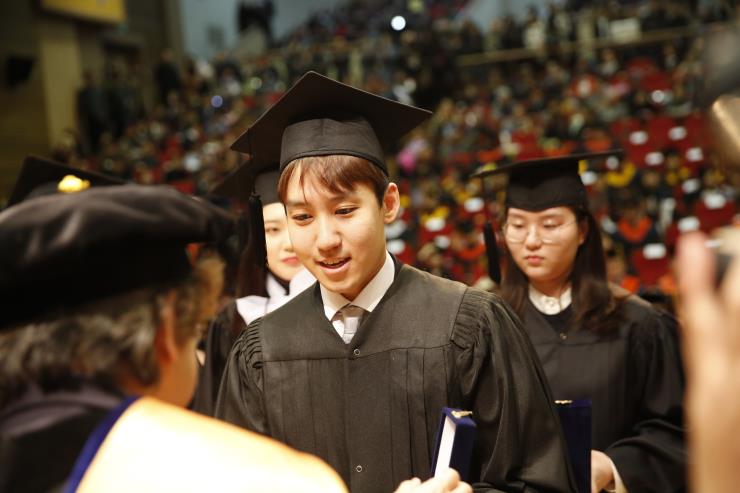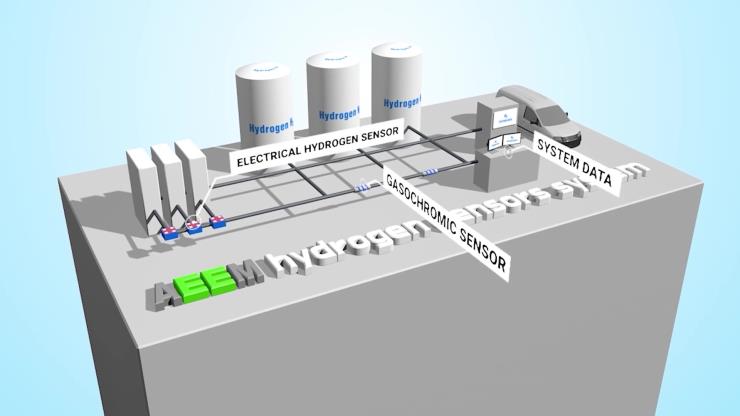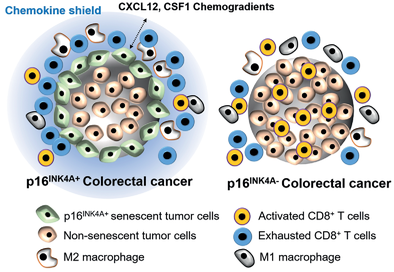-
Ajou University has signed a memorandum of understanding (MOU) with Hanhwa Systems, agreeing to organize and strengthen research collaboration over self-driving mobility. A ceremony was held on February 22 at Yeonam Hall on campus to mark the signing of the memorandum. Executive Vice President for University-Industry Cooperation Oh Yeong-tae and Hanhwa Systems’ R&D Director Lee Su-jae [KHTC1]signed and exchanged two copies of the memorandum. The ceremony was also attended by Hanhwa Systems researchers and Ajou faculty members affiliated with the ACES Mobility Industrial Cooperation Center[KHTC2], including Prof. Song Bong-seob (Department of Mechanical Engineering) who chairs the center. This MOU paves the way for increased collaboration between Ajou and Hanhwa specifically over research and development of night vision technology, the use of available research equipment and infrastructure, organization of a committee and exchange of technical advice, and development of related education and training programs. Car-mounted thermal-imaging night vision cameras are essential to nighttime safety with self-driving cars. Designed to provide cars with vision during both the day and night and particularly in visibility-compromised conditions, night vision technology is emerging as a key to the success of autonomic mobility. Ajou and Hanhwa Systems will work together closely toward developing an intelligent, AI-controlled thermal imaging engine module to be mounted on existing models of thermal imaging cameras. Ajou University’s LINC+ Project Group runs a number of industrial cooperation centers (ICCs) to strengthen the University’s research specialties through collaboration with local businesses and industries. There are currently four ICCs dedicated to smart mobility, biotechnology and healthcare, new and renewable energy, and AI and big data.
-
493
- 작성자OIA
- 작성일2021-03-19
- 7599
- 동영상동영상
-
A team of researchers from multiple organizations, led by Prof. Kim Ju-min (Departments of Chemical Engineering and Energy Systems Research) and his team, has developed a microscale flow mixing technique capable of synthesizing more even nanoparticles. The researchers expect their latest discovery to have a wide range of applications, including medical diagnostics, as well as preprocessing of specimens and reaction-based processes in microfluidics. Prof. Kim’s team worked with two other teams, led by Prof. Lee Chang-soo of Chungnam National University and Dr. Lee Sung-sik of ETH Zürich, respectively, to produce a microscale reactor. Their findings were published in a paper entitled, “Gear-shaped micromixer for synthesis of silica particles utilizing inertio-elastic flow instability,” featured on the cover of the February 7 issue of Lab on a Chip. Profs. Kim and Lee and Dr. Lee participated as corresponding co-authors. Hong Sun-ok, a recent graduate of Ajou University with a doctorate in energy systems research and now affiliated with Lotte Chemical, was listed as first author. Microfluidics is increasingly used in a number of applied fields, most notably for engineering point-of-care diagnostic devices that provide fast diagnosis. Efficient mixing of fluids is a crucial prerequisite for the preprocessing and core reactions of specimens in microfluidics. It is also the key performance requirement of micromixers. Given the near impossibility of generating turbulence in micromixers, the inefficient expansion-based mixing method has been preferred thus far. Manual mixing, which relies on conventional fluid dynamics, requires fluid channels with complex designs and complex manufacturing processes. Moreover, as layer-based mixing requires normal-state flows of fluid, the mixed output is prone to sedimentation along the fluid surface. Prof. Kim and the researchers discovered that flow instability, associated with diluted polymeric solutions, increases greatly in serpentine microscale channels that repeatedly contract and expand. They decided to apply this discovery to the development of a new micromixer with significantly greater efficiency. The inertio-elastic micromixer that came out of this discovery offers greater mixing efficiency at a wider range of flow rates. In other words, it is capable of more efficiently mixing a wider variety of fluid materials with greater simplicity. The researchers expect that their new model can be more easily applied to large-capacity micromixers. The researchers indeed applied their new micromixer to the synthesization of silica nanoparticles and confirmed that it was capable of producing particles of a more uniform size distribution (as measured in terms of distribution of particles of different sizes in a given specimen). They also demonstrated that their mixer was able to produce nanoparticles over a long span of time without the fluid channel becoming blocked—a problem common with conventional mixers. Prof. Kim explained: “Our study demonstrates that it is possible to design a micromixer capable of maximizing flow instability of viscoelastic fluids like polymer solutions. Our study is also significant because it demonstrates our technique by applying it to the synthesis of actual nanoparticles with a uniform size distribution.” This research has been made possible in part with support from the National Research Foundation of Korea’s Advanced Center of Excellence and personal research grants.# Captions* Upper left: The serpentine channel developed by Prof. Kim’s team, and a conceptual diagram of how it increases inertio-elastic flow instability to facilitate mixing.* Lower left: Particles mixed in a Newtonian fluid (a) show size distribution with a wide variance and nonspherical shapes (b). Particles synthesized in a dilute polymer solution with the help of inertio-elastic flow instability (c) boast uniform sizes and spherical shapes (d).* Right: Cover of the February 2021 issue of Lab on a Chip featuring Prof. Kim’s study.[Source: https://doi.org/10.1039/D0LC00834F]
-
491
- 작성자OIA
- 작성일2021-03-19
- 7836
- 동영상동영상
-
A team of researchers from Ajou and Seoul National universities has discovered a new way to control the pace of cellular aging. The key anti-aging solution found consists in the reconfiguration of telomeres, often understood as “timers” of cell division, which promises to unlock the secret of aging. The findings of the latest research were published under the title, “Telomeres reforged with non-telomeric sequences in mouse embryonic stem cells” in the February 17 issue of Nature Communications, a prestigious publication on natural sciences, with Prof. Park Dae-chan (Departments of Biological Sciences and Molecular Science and Technology) from Ajou University and Prof. Lee Jun-ho from Seoul National University listed as corresponding authors. Kim Da-eun, currently studying molecular science and technology at Ajou’s graduate school, was also listed as a co-author. The cells that make up the human body continue to divide and multiply to sustain the natural functions of life and growth. At some point in time, however, cells stop dividing, while some genetic information is lost as cells repeat division. Telomeres are protective sheaths found at the tips of chromosomes that serve as a kind of shield against the loss of genetic information during cell division, as telomeres are lost instead of vital genetic information. As telomeres shorten to a certain length or below, cells stop dividing and begin aging. Cells that continue to divide more actively than others, such as reproductive cells, stem cells, and cancer cells, utilize an enzyme known as telomerase to maintain the telomeric lengths and continue to divide almost infinitely. In other words, the continued healthy functioning of cells relies crucially on regulating the lengths of telomeres and the number of times cells divide. An accurate understanding of how telomeres can best be preserved may be essential to effective cancer treatment and anti-aging strategies with minimal or no risk of side effects. Researchers have discovered a mechanism known as alternative lengthening of telomeres (ALT) in certain cancer cells, which maintains telomeric length without utilizing telomerase enzymes. In human cancer cells, however, researchers have so far found telomeres that utilize the ALT mechanism but whose sequences simply follow the general and repetitive pattern.The researchers on Prof. Park’s team have discovered, for the first time in the world, a recombination of telomeres with unique sequences in a mammalian model. A small number of embryonic stem cells from a mouse with its telomerase inactivated went on to activate the ALT mechanism to recover the normal pace of cell division. The cells divided by this ALT mechanism displayed amplified unique sequences. Prof. Park’s team named the new pattern they discovered the mouse template for ALT (mTALT), arguing that it provided clues as to the possible existence of alternative telomeres in human cancer cells as well.The researchers, moreover, employed a multi-omics analysis to trace how the ALT mechanism actually works, subjecting the mouse embryonic stem cells at diverse stages of growth—cells with normal telomeric lengths, cells in the aging stage, cells after ALT activation, etc.—to analyses of genomes, transcriptomes, single-cell transcriptomes, and proteomes. They were thus able to identify and demonstrate the molecular characteristics of ALT cells.The researchers commented: “Our recent study reveals the possible existence of alternative telomeres in human cancer cells. We have demonstrated that the concept of telomeres extends beyond the repeated sequencing structures found at the tips of chromosomes and telomerase, but may also encompass diverse mechanisms that protect the tips of chromosomes.”The research was made possible with support from the Ministry of Science and ICT and the National Research Foundation of Korea’s support programs for new and experienced researchers.Mechanism of telomeric change and ALT activation due to cell division
-
489
- 작성자OIA
- 작성일2021-03-19
- 7614
- 동영상동영상
-
Ajou University’s Graduate School of International Studies (GSIS) will soon offer a master’s program in civil society leadership in Asia with the aim of educating and training future leaders to expedite development in developing countries.On February 16, the GSIS was officially appointed by the Korea International Cooperation Agency (KOICA) as an agency to operate KOICA’s Asian Civil Society Leadership Program. This postgraduate education and training will be provided by the GSIS with government grants totaling KRW 2 billion over the five years from 2021 to 2025. KOICA has been supporting the development of master’s degree and training programs at Korean universities to facilitate the development of future leaders from around the world who can contribute to the economic and social progress of their respective countries. This year’s program focuses particularly on cultivating civil society leadership for Asia. As such, it will emphasize sharing the experiences and lessons of civil society growth in Korea with future leaders who will go on to foster strong civil societies in their own countries. The GSIS, which won the competitive bidding process to form a partnership with KOICA, will organize three training programs over the next five years, recruiting 15 students for each training program for a total of 45 students. The curriculum will focus on ways to support the growth of civil societies in emerging economies across Asia and ways to enhance human capabilities for establishing a global cooperation system. Trainees will undergo 17 months of education and training toward obtaining a master’s degree in civil society/civil society leadership. Kang Shin-goo (Department of Political Science and Diplomacy) will oversee the program. The GSIS has been developing its expertise on providing education and training for international development cooperation through a number of KOICA-supported postgraduate programs it has offered in international commerce and management, industrial and trade policies, and energy policy since 2004. Prof. Kim Byoung-kwan, Dean of the GSIS, commented: “The new Civil Society Leadership Program is a human resource development program aiming at facilitating the growth of healthy civil societies in developing countries. By sharing Korea’s experiences with future leaders recruited from partner countries, we will be able to pave the way for burgeoning civil societies in their respective countries and also enable them to respond better to common global issues.”
-
487
- 작성자OIA
- 작성일2021-03-19
- 7444
- 동영상동영상
-
-
485
- 작성자OIA
- 작성일2021-03-19
- 5882
- 동영상동영상
-
A team of Ajou University researchers has uncovered a new optical phenomenon in graphene, widely regarded as a material that holds the key to the future. The team’s findings are expected to pave the way for developing new applications, including superspeed optical signal processing using two-dimensional materials, quantum communications, and quantum sensing.Prof. Yeom Dong-il (Departments of Physics and Energy Systems Research, pictured left) and his team have discovered that interlaying two stacks of single-layer graphene can produce considerably more nonlinear optic signals. Their findings were published under the title, “Enhanced third-harmonic generation by manipulating the twist angle of bilayer graphene,” in the January 21 online issue of Light: Science & Applications (IF = 13.714, IF (%) = 2.577).The paper lists two of Ajou’s doctoral students, Ha Seong-ju (pictured middle) and Park Nam-hun (pictured right), as first authors. The credit also goes to Profs. Lee Jae-hyun (Department of Materials Science and Engineering), Yoo Young-dong (Department of Chemistry), Park Ji-yong (Department of Physics), and Ahn Kwang-jun (Department of Energy Systems Research), as well as Prof. Jung Je-il (Department of Physics) from the University of Seoul.Graphene, a two-dimensional material well known for its composition of pure carbon atoms, has been garnering much attention around the world for its high conductivity and transparency as well as flexibility—all the properties desired in next-generation materials for electronic and optical diodes. Stacking layers of single-layer graphene at an angle produces Moiré superlattices. Graphene has recently captured researchers’ attention as the angle at which these layers are stacked can produce dramatically different results, including both a superconductor with zero resistance and a perfect insulator. The Moiré pattern refers to superlattices that emerge with much greater frequency than with the original and denser patterns of nets or fabrics layered together at an angle.Prof. Yeom’s team seized upon the nonlinear optic phenomenon that occurred when strong light was projected onto their twisted bilayer graphene (tBLG). The Moiré superlattices of the tBLG, in particular, gave rise to van Hove singularities (i.e., points at which the state density function of electrons peak-like discontinuities) with the state density of electrons. Moreover, the team discovered that, when the energy gap between the van Hove singularities tripled the energy of light being projected, significant enhancement occurred in the third-harmonic generation (THG) efficiency. Based on this finding, the team was able to increase the nonlinear optic signals of the electrically controlled tBLG by as much as 60 times those of single-layer graphene.Prof. Yeom commented: “With this study, we became the first in the world to demonstrate that the angle at which graphene is stacked can be a new significant variable when it comes to controlling and enhancing the nonlinear optic properties of two-dimensional materials. I expect that our findings will contribute to the development of new superspeed optical signal processing techniques or quantum lighting sources that utilize the nonlinear optic properties of two-dimensional materials.”The study was conducted with support from the National Research Foundation of Korea’s Experienced Researcher Support Program and Korea Energy Technology Evaluation and Planning’s Energy Workforce Development Program. Left: An optical microscope image of twisted bilayer graphene. The different colors represent the areas of graphene layers stacked together at different angles of rotation/twisting. Right: The third-harmonic generation image of bilayer graphene.
-
483
- 작성자OIA
- 작성일2021-03-19
- 5927
- 동영상동영상
-
New international student orientation for spring semester 2021 was held on February 25th via zoom.200 international students including undergraduate, graduate students, and exchange students participated in the orientation. Also, Ajou University's global supporters, AGA(Ajou Global Ambassador), participated to introduce global supporters.The Office of International Affairs offers orientations for new international students every semester. This year, the event was held through ZOOM due to the COVID-19.Following President Hyungju Park's welcoming speech, the event was held in the order of ▲ Introduction of Campus ▲ Sharing Information about the Courses and School Life ▲ Sexual Violence Prevention Education Program ▲Time to interact with Ajou global supporters (AGA, Ajou Global Ambassador). Students learned various information related to campus life and had networking time to get to know each other.In the welcoming speech, President Park said "whether you begin your experience online or in-person, I know your international studies will broaden global experiences for you and all members of the Ajou family."About 300 new international students from 41 different countries joined Ajou campus this semester. In addition, a total of six lectures, including business administration, Korean language, and general courses will be provided under the Ajou Virtual Exchange Program for international students who cannot enter the country due to the pandemic.Ajou offers various programs for new international students such as global supporters, NUBI, and etc. Through activities such as ▲Cultural Experiences ▲Field Trips, and ▲International Day, students can connect with one another and experience different cultures.A total of 1,000 international students from 70 countries, including new students, are studying at Ajou University this semester.
-
481
- 작성자OIA
- 작성일2021-03-04
- 4854
- 동영상동영상
-
The third Case-Based Learning Analysis Conference (CBLAC) was held on January 28, fostering debates on ways of applying artificial intelligence (AI) and big data to improve personalized learning conditions in higher education and increase the performance of adaptive learning.The conference, held by the Center for Teaching and Learning (CTL) at Ajou University, focused on the theme of “Introducing and Practicing Adaptive Learning in Higher Education.” The entire conference was livestreamed online via Zoom and YouTube, with 140 or so participants, drawn from both inside the school and outside, in attendance.Professor Jeong Jae-young of Ewha Womans University opened the conference with a keynote address entitled “The Age of AI: Direction for Innovations in Higher Education.” Professor Jeong introduced examples of innovation attempted by universities abroad and identified the lack of content and responsiveness in Korean universities’ AI education programs. He then stressed the necessity of changing pedagogic methods using AI.The keynote address was followed by a panel debate on preparations for introducing adaptive learning. Prof. Shin Jong-ho of Ajou University, who leads the CTL, was the first to speak, on the theme “Introduction and Practice of Data- and AI-Based Adaptive Learning at Ajou University.”Noting that the changing learning environment has increased the diversity of students, Prof. Shin emphasized the need to introduce personalized classes and learner-centered education methods that better cater to different students’ interests, aptitudes, and talents.Prof. Shin then proceeded to introduce Ajou’s model of adaptive learning, which supports personalized learning environments using AI. Adaptive learning refers to a method of education that utilizes intelligent information technology, such as big data analysis and AI, to assess individual students’ levels of knowledge and competency with accuracy and dynamically adjusts the types, content, and levels of education accordingly. Adaptive learning is chiefly designed to provide personalized learning environments tailored to different students’ needs.Since launching the development of the Ajou Teaching and Learning Analytics System (ATLAS) in 2014, Ajou University has been promoting adaptive learning on campus, culminating into the creation of the Pathway to Ajou Student Success (PASS), a data- and AI-based personalized learning system that was introduced in 2019.Prof. Shin relayed that dividing students into different groups and applying prescriptive learning programs accordingly, with the help of Ajou’s model of adaptive learning, has improved students’ satisfaction with classes. Nevertheless, he also pointed out a number of obstacles preventing the progress of adaptive learning, including the lack of programs and curricula developed in Korea, language barriers, and resistance to the introduction of new systems. “As we are still in the early stages of adaptive learning,” he added, “it is necessary to develop more effective measures by pooling the experiences and lessons that Korean universities have gained.” The second debate unfolded on the theme of “Adaptive Learning-Applied Syllabi.” Prof. Hwang Eun-kyung of Ajou University first spoke about “Ai-Based, High-Intensity, Interactive Teaching Method: ALEKS Chemistry.” ALEKS is a program designed to enable individual students to learn at different paces and levels of difficulty. Prof. Hwang provided classes using Ajou’s own adaptive learning system and ALEKS, and compared the results.The professor noted that, although ALEKS automatically assessed students’ different levels of competency, the different workloads it imposed on students at different levels and the English lessons burdened some students. On the other hand, Prof. Hwang noted that Ajou’s own system enabled her to group students for group exercises based on assessment of their competency, and that such exercises significantly improved students’ satisfaction.Concluding, from her experience, that the truly important question of adaptive learning involves deciding how to apply the information on students it provides to classroom content and learning, Prof. Hwang argued that we need to “prepare different ways of teaching other than classroom learning based on a good understanding of how the adaptive learning system works.”Prof. Kan Jin-sook of Hallym University and Prof. Kim Heon-joo of Handong Global University also gave presentations under the themes “The AI-AL Innovation Strategy for Hybrid Learning at Hallym” and “A Case of AI-Based Personalized Education: ALEKS Statistics,” respectively.In his official greeting, Ajou President Park Hyung-ju remarked: “Ajou’s attempts to apply data-based analyses and strategies to the evolving learning environments predate COVID-19.” He also added: “I hope, through this conference, we can share our experiences with and lessons on adaptive learning in higher education toward finding a better way forward for all Korean universities.”The Ajou CTL provides consultation on class designs, develops new models of teaching and learning based on the latest methods, and provides learning advisory programs. The center’s scope of work has expanded recently to include content development, learning management systems, and other matters related to remote learning, allowing it to build a data-based teaching and learning support system capable of providing proactive and personalized support programs for different learning needs.Prof. Shin Jong-ho hosting the conferenceConference poster
-
479
- 작성자OI***
- 작성일2021-02-23
- 5100
- 동영상동영상
-
A joint team of researchers from Ajou University and Sungkyunkwan University has developed an ultra-sensitive graphene ion sensor using a novel acidity-detecting mechanism. This groundbreaking discovery, which transcends the theoretical limit expected of such sensors, is expected to have various applications, including for Internet-of-Things (IoT) devices and diagnostic equipment.The team, co-led by Prof. Lee Jae-hyun (Dept. of Materials Science and Engineering / Graduate Dept. of Energy Systems Research) of Ajou and Prof. Whang Dong-mok of Sungkyunkwan, published their findings under the title “Super-Nernstian pH Sensor Based on Anomalous Charge Transfer Doping of Defect-Engineered Graphene” as the featured article in the January 13 issue of Nano Letters (IF = 11.238), a prestigious journal on nanoscience and technology. Both professors were featured as the corresponding authors, with Dr. Jung Su-ho of Sungkyunkwan’s Advanced Institute of Nano Technology as the first author, and Hyun Sang-hwa, a graduate student in Ajou’s Dept. of Energy Systems Research, as a co-author.Thanks to its high conductivity and the exposure of its components on the surface, graphene has been garnering much attention as an ideal material for sensors. The low surfactant reactivity due to the low defect density, however, makes it difficult for the substances to be detected—ions, molecules, etc.—to attach to the graphene.Until recently, much of graphene research has therefore focused on inducing and increasing defects on the surface of the material so that other materials may be better absorbed by it. This increase in mechanical defects, however, also compromises the desirable qualities of graphene, preventing researchers from transcending the theoretical limit on sensitivity.Prof. Lee and his team have sought to overcome this dilemma by controlling the density of nuclei formed in the early stage of graphene synthesis so as to control the shape and size of the grains found on the resulting product. This nuclear growth density control method has enabled the researchers to produce a nanocrystalline graphene with engineered defects so as to permit the selective penetration by ions. In other words, the team has come up with a novel detection mechanism utilizing the reaction between graphene-penetrating ions and the substrate underneath.As a result, the team has developed a highly sensitive nanocrystalline graphene-based pH sensor that is capable of achieving a sensitivity as high as 140mV/pH under optimized conditions, far exceeding the marginal sensitivity of 59mV/pH associated with conventional pH sensors.Emphasizing that they were the first in the world to find a new sensing mechanism capable of transcending the theoretical sensitivity limit, Prof. Lee and his team assessed that their defect-engineered nanocrystalline graphene harbors much potential for producing “highly sensitive semiconductor ion sensors with possible applications in IoT and medical devices.”This study was made possible with the support of the research support programs for basic research labs and seasoned researchers provided by the National Research Foundation of Korea.Sensing mechanism of the nanocrystalline graphene pH sensor*Gr = graphene, nc-Gr = nanocrystalline grapheneChanges in the nanocrystalline graphene pH sensor’s sensitivity with different substrate conditionsFeatured on the cover of Nano Letters
-
477
- 작성자OI***
- 작성일2021-02-23
- 5280
- 동영상동영상
-
According to the “Employment Rate of University Graduates in February 2019 (Including Those Who Graduated in August 2018)” posted by the Ministry of Education, Ajou came in eighth among four-year research universities with 1,000 or more graduates in the Seoul-Gyeonggi region with a graduate employment rate of 70.4 percent.The average employment rate of all graduates from the 227 four-year universities nationwide dropped by a full percentage point to 63.4 percent. Since peaking at 65 percent in 2015, the national average has struggled to break through that threshold, recording 64.9 percent in 2016, 64.6 percent in 2017, 62.8 percent in 2018, and 64.4 percent in 2019.Among the 2,184 Ajou students who graduated in either August 2018 or February 2019, 70.4 percent have landed jobs. The School of Medicine had the highest employment rate at 100 percent, followed by the College of Pharmacy (89.7 percent). The other departments and colleges with higher-than-average graduate employment rates included the Department of Transportation System Engineering (86.7 percent), College of Nursing (82.6 percent), Department of Mathematics (80.8 percent), Department of Digital Media (79.8 percent), Department of History (77.8 percent), Department of Financial Engineering (77.4 percent), Department of Software (76.4 percent), Department of Industrial Engineering (76.3 percent), Department of Mechanical Engineering (75.2 percent), and Department of Electrical and Computer Engineering (74.4 percent).Not only was Ajou ranked highly, in eighth place, among the four-year universities with 1,000 or more graduates in Seoul-Gyeonggi, but it also came in eighth among the 30 universities ranked highly on The JoongAng Daily’s University Rankings 2019. Sungkyunkwan University, Hanyang University, Sogang University, Korea University, Yonsei University, Chung-Ang University, and Seoul National University were also ranked highly, with average graduate employment rates ranging from 70.9 percent to 78.6 percent.Ajou’s graduates also had an employment retention rate of 89.3 percent, which is calculated using workplace-based National Health Insurance data to see who among university graduates have maintained their workplace-based insurance policies for one year since landing their first job. High employment retention rates are often interpreted as indicating the decency and security of jobs that university graduates have found.Ajou came in eighth again among the 30 highest-rated universities on The JoongAng Daily’s University Rankings 2019 with a graduate employment retention rate of 89.3 percent. The other universities with higher rates were Sogang University, Sungkyunkwan University, the University of Seoul, Korea University, Hanyang University, Yonsei University, and Seoul National University, whose rates ranged from 90.4 percent to 93.3 percent.Ajou provides career path counseling and employment support programs for not only enrolled students and graduates but also local youth through its Career Development Center. The center helps younger enrolled students explore their career paths and enables older enrolled students to develop occupational competency and other skills they need to find jobs. It provides one-on-one counseling with expert advisors, short-term occupational training programs (offering courses on Excel, video production, coding, big data, etc.), mentoring from graduates, career camps for transfer students, and job lectures (semiconductors, secondary cells, etc.), in addition to various special lectures and AI-based interview preparation programs.The latest graduate employment rates were calculated as of the end of 2019 with respect to university students who graduated in either August 2018 or February 2019.Go to Ajou’s Career Development Center website.
-
475
- 작성자OI***
- 작성일2021-02-23
- 6247
- 동영상동영상
-
A team of researchers led by Ajou’s Prof. Seo Hyung-tak has successfully developed a high-precision sensor capable of detecting high concentrations of hydrogen. The researchers expect their work to help enhance the safety of hydrogen energy, supporting the production and application of hydrogen in the future.Prof. Seo (Dept. of Materials Science and Engineering / Graduate Dept. of Energy Systems, pictured) and his team have invented a high-precision hydrogen sensor capable of detecting hydrogen at all levels of concentration, from particles per million (ppm) to 100 percent, using a new material created by combining an ultra-thin, multilayered, alloyed catalyst and electrodes. Their discovery was published in a paper entitled “Confined interfacial alloying of multilayered Pd-Ni nanocatalyst for widening hydrogen detection capacity” in the January 1 online issue of Sensors & Actuators B: Chemicals, an international journal on sensing technology. Dr. Lee Young-Ahn and Dr. Le Thai Duy, both of Ajou University, were featured as the co-first authors. The team also included Prof. Kim Hyun-you of Chungnam National University and Dr. Park Ju-cheol of the Gumi Electronics and Information Technology Research Institute.The range of possible applications of hydrogen as an alternative source of energy for automobiles, electricity generation, and other industries has been expanding rapidly as of late. The growing demand for hydrogen fuel cell vehicles, in particular, highlights the importance of developing hydrogen applications for eco-friendly transportation. Safety, however, has been a chief issue hindering the rapid growth of hydrogen as a fuel. An odorless, colorless substance that is also extremely lightweight, hydrogen carries a significant risk of undetected leakage. It does not take much to trigger an explosion when the hydrogen concentration in the surrounding air reaches four percent. Because extremely high pressure is crucial to ensuring the high energy intensity (energy stored per unit volume) required of hydrogen as a fuel, it is critical to equip hydrogen-powered vehicles and other such machinery with well-functioning hydrogen detectors.Furthermore, to diversify the possible use of hydrogen for purposes including fuel cells, it is essential to have a device capable of monitoring and controlling the purity and concentration of hydrogen. High-precision sensors capable of monitoring high concentrations of hydrogen (95 to 100 percent) are in particularly high demand. Such high-concentration hydrogen sensors, however, can be very complex to develop. There are only a handful of expensive options available on the market worldwide today. None of the existing products, furthermore, are able to detect a wide range of hydrogen concentrations ranging from ppm levels to 100 percent.With the goal of finding a high-precision, highly reliable alternative to the palladium (Pd) catalyst electrodes that are widely used in the conventional chemically resistant hydrogen sensors, the Ajou researchers have developed a new electrode by layering ultra-thin films of Pd and nickel (Ni) in a lattice-like fashion, with each layer having a thickness on the nanometer scale. Numerous existing structures using either a Pd film or nano-Pd structure are capable of detecting hydrogen at limited and low concentrations, but have proven hopelessly incapable of detecting hydrogen at concentrations of 50 percent or above. The hydrogen atoms decoupled from hydrogen molecules by the Pd fail to desorb from Pd lattices, thereby saturating the hydrogen signals, while repeated hydrogen detection also hydrogenates the Pd film or structure, destroying the catalyst.Prof. Seo and his team’s ultra-thin Pd-Ni interfacial super-lattice is capable of detecting high concentrations of hydrogen with incredible precision. It has indeed demonstrated top-notch performance at all levels of concentration (linearity = 95 to 99 percent, response time of less than three seconds, and signal variation of one percent or less). The new sensor even stably maintained its high performance throughout the repetitive accelerated durability test (hydrogen detected 40,000 times), a key step before the manufacture of hydrogen fuel cell parts. Furthermore, the team has demonstrated, through atom-level calculations and ultra-high-resolution transmission electron microscopy (TEM), that the success was entirely due to the structural stability of the Pd-Ni nano-surfactant alloy (only two to three nanometers in thickness) and its ability to reduce the energy required for hydrogen desorption.Prof. Seo’s team unveiled its latest invention at Consumer Electronics Show (CES) 2021, an exposition of today’s most cutting-edge technologies. Due to the pandemic, this annual IT and appliance industry expo, the largest of its kind in the world, was held exclusively online from January 11 to 14 this year.Prof. Seo explained: “Korean companies are solidifying their leadership in hydrogen fuel cell vehicles now that the demand for hydrogen energy is growing worldwide. Nevertheless, these companies have had to rely on very expensive and imported hydrogen sensors in order to ensure the safety of their products.”He added: “We are working on developing additional technologies to ensure the broad application of our new invention to hydrogen monitoring systems. Such systems have a wide array of potential applications in all hydrogen-using industries and sectors, including energy infrastructure, semiconductors, and petrochemicals.”The team’s study was made possible with the support of the Energy Technology Development Program of the Ministry of Trade, Industry and Energy and Korea Institute of Energy Technology Evaluation and Planning, as well as the Research Support Program for New Researchers with Advanced Overseas Accomplishments, Basic Research Support Program, and BK21 Four Program of the Ministry of Science and ICT and National Research Foundation of Korea. The team has been granted a patent for their sensor in Korea, and their applications for patents worldwide are in progress.Image of Prof. Seo Hyung-tak and his team’s hydrogen sensor shown at CES 2021
-
473
- 작성자OI***
- 작성일2021-02-23
- 5141
- 동영상동영상
-
A team of researchers led by those affiliated with the Ajou School of Medicine has demonstrated the existence of a chemical shield that protects tumor cells against attacks by immune cells, revealing a pathway to a new potential tumor treatment strategy.The team, led by Prof. Park Tae-jun (Dept. of Biochemistry and Molecular Biology), Prof. Kim Jang-hee (Dept. of Pathology), and Prof. Choi Yong-won (Dept. of Oncology-Hematology), has found that senescent tumor cells found in colorectal cancer serve to prevent immune cells from infiltrating the tumor, rendering them ineffective and thereby promoting the progression of colorectal cancer. The team’s findings were published in a paper entitled “Senescent Tumor Cells Build a Cytokine Shield in Colorectal Cancer” in the January 4 issue of Advanced Science.Senescent cells no longer grow and multiply, but still secrete a variety of substances. Micro-environmental changes associated with diverse illnesses have been attributed to the strong metabolic activities of these senescent cells. Until now, however, little had been known about how these old cells affect cancerous growths.Having verified the presence of senescent tumor cells in a surgically extracted specimen of colorectal cancer, the Ajou researchers observed that, the greater the number of senescent tumor cells found in a specimen, the slower the penetration of cytotoxic T-cells. The researchers also assayed the secretions found on the surfaces of senescent tumor cells and identified two specific cytokines responsible for the function of immune cells.The researchers demonstrated that CXCL12, a chemokine, inhibits the infiltration of cytotoxic T-cells into tumor cells, while CSF1, a cytokine, catalyzes the differentiation of macrophages that induce this immunosuppressant effect, thereby undermining the functioning of cytotoxic T-cells. They also found that, by inhibiting CXCL12 alone in mice with colorectal cancer, cytotoxic T-cells infiltrate the tumor cells far better, significantly inhibiting tumor growth.Concluding that senescent tumor cells in colorectal cancer can affect the progression of the cancer, the researchers expressed hope that their findings will “aid research and lead to the development of a new treatment strategy for colorectal cancer, which is quite resistant to immunotherapy, by targeting senescent tumor cells or the secretions they produce to inhibit immunotherapy.”This study was made possible with the support of the University-Centered Research Lab Support Program and Basic Research Program of the Ministry of Education, the National Research Foundation of Korea (NRF), and the Bio and Medical Technology Development Program (for the Enhancement of Clinician Scientists’ Research Capabilities) of the Ministry of Science and ICT and the NRF.Immunosuppressant function of senescent tumor cells in colorectal cancer# Pictured from left to right: Prof. Park Tae-jun (Dept. of Biochemistry and Molecular Biology), Prof. Kim Jang-hee (Dept. of Pathology), and Prof. Choi Yong-won (Dept. of Oncology-Hematology).
-
471
- 작성자OI***
- 작성일2021-02-23
- 4519
- 동영상동영상
 아주대학교 국제대학원
아주대학교 국제대학원